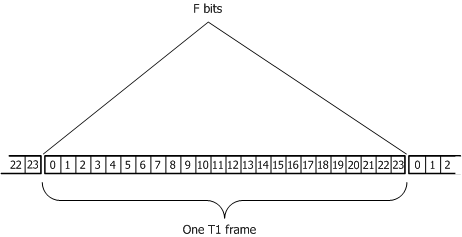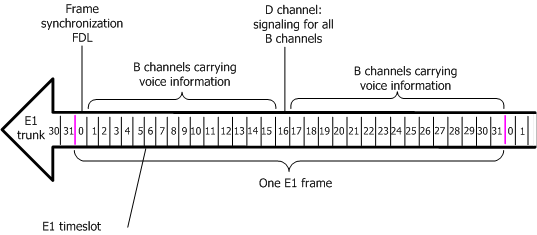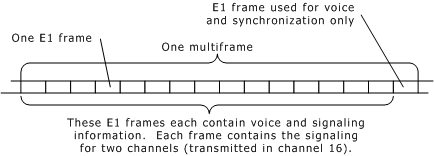
On T1 and E1 trunks, the data in the channels is combined into a single continuous stream of data using time-division multiplexing (TDM). With TDM, the channels take turns sharing the trunk over and over again. Each channel broadcasts 8 bits at a time. The time given a channel during a given round is called a timeslot. One cycle of timeslots is called a frame.
T1 and E1 delineate frames differently. This topic describes:
When configuring the CG 6060 board, you specify which framing format to use with the NetworkInterface.T1E1[x].FrameType keyword.
On T1 trunks, a frame consists of 24 timeslots, sent every 125 µsec (1/8000 sec). The following illustration shows a T1 frame:

The CG 6060 board supports two T1 framing formats: D4 framing and extended superframe (ESF).
With D4 framing, a single framing bit (F bit) is sent after each frame, to mark the end of the frame and the beginning of the next one. Each frame consists of (24x8)+1 = 193 bits. The framing bits (8000 per second) take up the extra bandwidth.
The following illustration shows the framing bits on a T1 trunk:

After each frame, the F bit is set or reset according to a pattern that repeats once every 12 frames: 100011011100. This makes the F bit recognizable even in the high-speed T1 bit stream. The 12 frames in this cycle constitute one superframe.
With CAS protocols, the least significant bit in each timeslot is robbed for signaling in the 6th and 12th frames in each superframe. Since each bit has only two possible states (0 or 1), only four separate signaling conditions can be transmitted with CAS protocols.
The following illustration shows robbed-bit signaling (D4 framing format):

With ESF framing, an extra bit appears after every frame, as in D4 framing. However, only every fourth extra bit is used for framing. This bit is set or reset in a pattern that repeats once every 24 frames, instead of the 12-frame repetition in D4 framing. The 24 frames in the cycle constitute one extended superframe.
All of the other extra bits (18 in all) are used alternately:
Six of the bits are used for a cyclic redundancy check (CRC), to detect errors.
The other 12 carry diagnostic data. This bandwidth is called the facilities data link (FDL).
With CAS protocols, bits are robbed from each timeslot in the 6th, 12th, 18th, and 24th frame in the extended superframe (as shown in the following illustration). Instead of two signaling bits per superframe, ESF has 4 bits, allowing up to 16 separate signaling conditions to be transmitted.
The following illustration shows an extended superframe:

On E1 trunks, a frame consists of 32 timeslots. A frame is sent every 125 µsec (1/8000 sec). The following illustration shows an E1 frame:

In each frame, channels are numbered 0 through 31. Half of the first channel (channel 0) is used for frame synchronization. The other half can be used as a facilities data link (FDL).
With CAS protocols, signaling information for each channel is carried in channel 16. This eliminates the need for robbed-bit signaling. Channels 1 through 15 and 17 through 31 (30 channels in all) carry voice information. The following illustration shows CEPT E1 timeslots:

With CAS protocols, four ABCD bits are sent for each channel at a time. Since timeslot 16 can carry only 8 bits of information per frame, it is not possible to send the signaling for all 30 channels in each frame. Therefore, channels take turns using channel 16, two at a time. It takes 15 frames to cycle through the signaling for all channels.
After every 15 frames, an extra frame is sent to synchronize the receiver to the signaling channel. Thus the full cycle contains 16 frames. A group of 16 such frames is called a multiframe. The following illustration shows an E1 multiframe:
